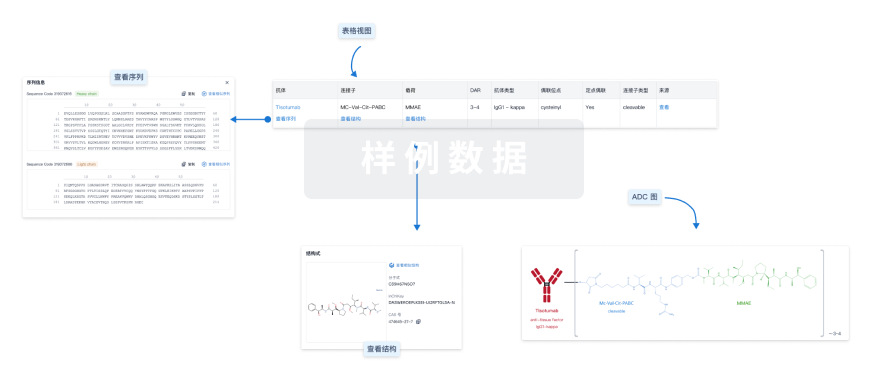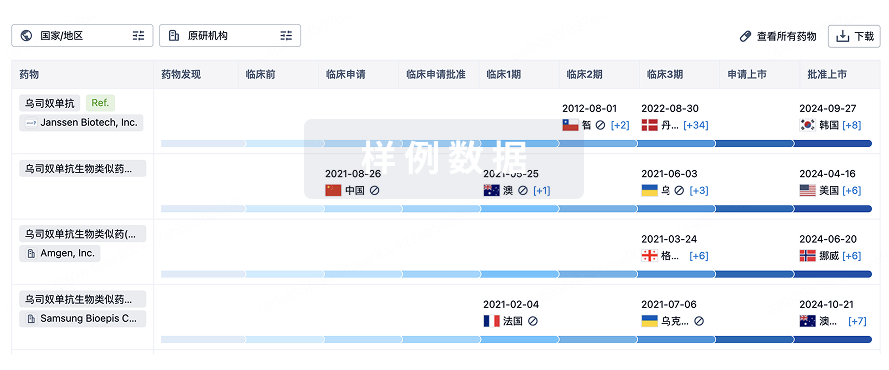预约演示
更新于:2025-10-30
AZD-5335
更新于:2025-10-30
概要
基本信息
原研机构 |
非在研机构- |
权益机构- |
最高研发阶段临床3期 |
首次获批日期- |
最高研发阶段(中国)临床1/2期 |
特殊审评- |
登录后查看时间轴
结构/序列
使用我们的ADC技术数据为新药研发加速。
登录
或

Sequence Code 1179457098

Sequence Code 1179457100

关联
3
项与 AZD-5335 相关的临床试验NCT07218809
A Randomised, Open-label, Phase III Study of AZD5335 Versus Mirvetuximab Soravtansine in FRα-high and AZD5335 Versus Investigator's Choice Chemotherapy in FRα-low Expressing High-grade Platinum-resistant Epithelial Ovarian Cancer Patients (TREVI-OC-01)
The intention of the study is to demonstrate superiority of AZD5335 versus standard of care by assessment of progression-free survival (PFS) in women with high-grade, platinum-resistant epithelial ovarian, fallopian tube, or primary peritoneal cancer, expressing high or low FRα levels.
开始日期2025-11-28 |
申办/合作机构  AstraZeneca PLC AstraZeneca PLC [+3] |
CTR20240220
FONTANA:一项评估剂量递增的AZD5335单药治疗和与抗癌药物联合治疗在实体瘤受试者中的安全性、耐受性、药代动力学和初步疗效的I/IIa期、开放性、多中心模块化研究
1. 评估AZD5335单药治疗和与抗癌药物联合治疗在晚期实体瘤受试者中的安全性和耐受性。
2. 确定AZD5335单药治疗和与抗癌药物联合治疗进入II期研究的有效剂量(RP2D)。
3. 评估AZD5335单药治疗和联合抗癌药物治疗的初步抗肿瘤活性。
4. 表征AZD5335单药治疗和联合抗癌药物治疗时的PK。
5. 测定AZD5335的免疫原性。
开始日期2024-02-19 |
申办/合作机构 阿斯利康全球研发(中国)有限公司 [+2] |
NCT05797168
A Modular Phase I/IIa, Open-label Study to Assess the Safety, Tolerability, Pharmacokinetics and Preliminary Efficacy of Ascending Doses of AZD5335 Monotherapy and in Combination With Anti-cancer Agents in Participants With Solid Tumors
This research is designed to determine if experimental treatment with Antibody-drug conjugate, AZD5335, alone, or in combination with anti-cancer agents is safe, tolerable, and has anti-cancer activity in patients with advanced tumors
开始日期2023-06-05 |
申办/合作机构 |
100 项与 AZD-5335 相关的临床结果
登录后查看更多信息
100 项与 AZD-5335 相关的转化医学
登录后查看更多信息
100 项与 AZD-5335 相关的专利(医药)
登录后查看更多信息
3
项与 AZD-5335 相关的文献(医药)2025-03-25·ANALYTICAL CHEMISTRY
Streamlined High-Throughput Data Analysis Workflow for Antibody-Drug Conjugate Biotransformation Characterization
Article
作者: Meissen, John K. ; Zhang, Yuzhuo ; Rosenbaum, Anton I. ; Huang, Yue ; Tan, Hui Yin ; Liu, Kate ; Yuan, Jiaqi ; Ai, Yongling
Research into antibody-drug conjugates (ADCs) is currently at an inflection point due to recent clinical impact. ADC biotransformation analysis is key for understanding the structural integrity of ADCs in vivo and is a critical aspect of drug development, especially at the lead selection stage. Data analysis of biotansformed products is hindered by the manual and time-consuming analyte identification process oftentimes taking days to weeks. We developed a streamlined data analysis workflow enabling more automated peak identification using several commercial software tools that significantly improve data processing efficiency. A linker-payload biotransformation library was created for each new molecule and combined with antibody sequence information for peak matching. As a proof of concept, we tested this workflow across different payload and linker types, acquired using different mass spectrometers: an example using a topoisomerase I inhibitor-conjugated ADC (SCIEX ZenoTOF 7600) and a comparison to a published in vivo ADC biotransformation data set for a pyrrolobenzodiazepine-conjugated ADC (ThermoFisher QE HF-X). Using this more automated workflow, we rapidly identified major biotransformation species that were previously found manually including loss of linker-payload, thiosuccinimide ring hydrolysis, cysteinylation at the deconjugation site(s), and partial linker-payload cleavage. This improved data-analysis workflow has demonstrated superb effectiveness in streamlining overall ADC biotransformation identification and enabled quantification that was highly comparable to previously obtained results. Broadening application of advanced analytical techniques to study biotherapeutic biotransformation can now more effectively impact drug development by enabling faster design-test-analyze cycle times, critical in early drug discovery settings, opening new avenues for more effective collaboration between analytical chemists and bioconjugate engineers.
2024-06-21·ORGANIC PROCESS RESEARCH & DEVELOPMENT
Route Design and Scale-Up of a Topoisomerase I Inhibitor Antibody–Drug Conjugate Payload
作者: Goundry, William R. F. ; Poulton, Andrew M. ; Cottineau, Bertrand ; Magne, Fanny ; Tang, Canlin ; Zhu, Xiaohong ; Tao, Haijun ; Dai, Kuangchu ; Welham, Matthew
AstraZeneca is currently developing an antibody-drug conjugate for the treatment of cancer with a topoisomerase I inhibitor payload.The drug portion of the mol. is an analog of the natural product camptothecin.We describe the initial scale-up of the synthesis to meet preclin. timelines, including route design work to shorten the route by five steps.We also detail several problems we encountered, most notably a low-yield final step.We developed a second-generation route to address these issues, increasing the overall yield from 3.4% to 7.8% while reducing the process mass intensity by 66%.We discuss the impurities formed throughout the process and highlight our workup and purification strategy to remove them.
CLINICAL CANCER RESEARCH
Derivation of AZD5335, a novel FRα-targeted TOP1i-loaded ADC, for the treatment of FRα-expressing cancers
Article
作者: Zenonos, Zenon ; Brier, Tim ; Cosulich, Sabina ; Rosfjord, Edward ; Meekin, John H. ; De Almeida, Ana ; Shandilya, Harini ; Beaumont, Kevin ; Anderton, Judith ; Dino, Iris ; Chesebrough, Jon ; Godfrey, Lisa ; Falck, Tillmann ; Pugh, Kathryn ; Myers, Claire ; Bisha, Ina ; Gasper, Diana ; Patel, Neki V. ; Lan, Lingyun ; Dodd, Roger B. ; Sapra, Puja ; Hood, John ; Cronin, Shane ; Zoeller, Jason J. ; Mitchell, Pat ; Saleh, Ali ; Thomas, Tima ; Naseer, Humaira ; Ward, Christopher ; Tilmont, Isabella ; Sargeant, Rebecca ; Gymnopoulos, Marco ; Christ, Simon ; Lehmann, Michael ; Cox, Megan ; Guza, Xhenifer ; Andoni, Alma ; Turner, Simon ; Hurt, Elaine ; Neal, Frances ; Recolin, Benedicte ; Lee, Nancy ; Tammali, Ravinder ; Wang, Jixin ; Chooi, K. Phin ; Fraenkel, Paula G.
Abstract:
Purpose: Folate receptor alpha (FRα) is expressed in most ovarian cancers. However, only patients with high expression levels are eligible for Elahere, an FRα-targeted microtubule inhibitor antibody-drug conjugate (ADC). Efficacy limitations and safety concerns underscore the need to develop next-generation FRα-targeted ADCs to treat tumors expressing variable levels of FRα and incorporate different payloads to reduce safety risks. Herein, we present the characterization of AZD5335, a novel FRα-targeted topoisomerase-1 inhibitor ADC. Experimental Design: The efficacy of AZD5335 was assessed and correlated with FRα-expression using cell- and patient-derived models. Focusing on models with low FRα, AZD5335 was directly compared to an Elahere-analog. Additionally, AZD5335 was evaluated in a model of acquired Elahere-resistance. Combined treatments including AZD5335 plus either standard-of-care drugs or a PARP1-inhibitor were also explored. Results: A single dose of AZD5335 (2.5mg/kg) achieved an overall response rate of 82% in ovarian cancer patient-derived xenografts (n=17). Anti-tumor responses were observed in models expressing both high and low levels of FRα. Specifically within FRα low models, AZD5335 demonstrated superiority over an Elahere-analog. In the context of acquired Elahere-resistance, AZD5335 treatments resulted in complete tumor regressions. Additionally, combining AZD5335 with standard-of-care drugs or a PARP1-inhibitor resulted in enhanced efficacy and sustained durability. Two clinical case studies that demonstrated significant AZD5335 responses in tumors exhibiting high and low FRα expression are also provided. Conclusions: AZD5335 is a promising next-generation ADC capable of targeting ovarian cancers with both high and low FRα expression. AZD5335 demonstrates efficacy in overcoming Elahere-resistance and supports combined treatment strategies.
47
项与 AZD-5335 相关的新闻(医药)2025-10-27
·雪球
来自智慧芽EurekaAgent平台1.拜耳“first-in-class”小分子获FDA批准上市10月24日,拜耳(Bayer)宣布,美国FDA已批准Lynkuet(elinzanetant)胶囊上市,用于治疗与绝经相关的中度至重度潮热(即血管舒缩症状,VMS)症状。Lynkuet是一款“first-in-class”的双重神经激肽-1,3(NK-1,3)受体拮抗剂,口服每天一次,是治疗绝经相关的中度至重度VMS的非激素类疗法。根据新闻稿,Lynkuet也是首款获批准用于治疗中度至重度潮热的的双重神经激肽(NK)受体拮抗剂。FDA的批准主要基于三项3期临床试验(OASIS-1、OASIS-2和OASIS-3)的数据,这些研究评估了Lynkuet用于治疗更年期中度至重度潮热的安全性和有效性。该疗法在三项研究中均达成所有主要终点,并展现出良好的安全性。2.恒瑞医药三合一口服降糖药获批上市10月24日,国家药品监督管理局(NMPA)官网显示,恒瑞医药的恒格列净瑞格列汀二甲双胍缓释片(HR20031片)的上市申请已获批准,用于经二甲双胍治疗后血糖仍控制不佳的2型糖尿病患者。HR20031片是恒瑞医药自主研发的钠-葡萄糖协同转运体2(SGLT2)抑制剂恒格列净、二肽基肽酶-4(DPP-4)抑制剂磷酸瑞格列汀和二甲双胍的固定剂量复方缓释制剂,通过三种不同作用机制达到降血糖作用,拟每日1次口服用于治疗经二甲双胍治疗后血糖仍控制不佳的2型糖尿病,以改善此类患者的血糖控制。2023年6月,该三药联合的III期临床试验(SHR3824-SP2086-MET-301)主要研究终点达到方案预设的优效标准。3.华东医药EGFR/HER2小分子抑制剂获批上市10月24号,国家药监局(NMPA)官网显示,华东医药的马来酸美凡厄替尼片(曾用名:迈华替尼)获批上市,用于表皮生长因子受体(EGFR)21号外显子L858R置换突变的局部晚期或转移性NSCLC成人患者的一线治疗一线治疗。马来酸美凡厄替尼片为一款新型、强效、高选择性、具有口服活性的不可逆EGFR/人表皮生长因子受体-2(HER2)小分子抑制剂。2024年5月,华东医药在ASCO大会上公布了该药对比吉非替尼一线治疗EGFR敏感突变的晚期非鳞状NSCLC患者的III期HDHY-MHTN-III-1907研究结果。结果显示,美凡厄替尼组mPFS显著优于吉非替尼组(13.73个月vs.9.66个月,HR=0.68,P=0.0024),总生存期(OS)数据尚未成熟。4.葛兰素史克BCMAADC获美国FDA批准上市10月23日,GSK宣布,美国FDA批准其抗体偶联药物(ADC)Blenrep(belantamabmafodotin)联合硼替佐米和地塞米松(BVd),用于治疗至少接受过两种既往疗法的复发或难治性多发性骨髓瘤(RRMM)成年患者。Blenrep的批准基于关键性3期临床试验DREAMM-7的数据。结果显示,Blenrep联合方案将患者死亡风险降低51%(HR=0.49,95%CI:0.32–0.76),中位PFS延长至31.3个月(95%CI:23.5–尚未达到[NR]),而活性对照组为10.4个月(95%CI:7.0–13.4),风险比为0.31(95%CI:0.21–0.47)。在中位OS方面,Blenrep联合治疗组与活性对照组分别为NR和35.7个月(95%CI:21.1–NR),风险比为0.49(95%CI:0.32–0.76)。5.罗氏「奥妥珠单抗」获美国FDA批准用于治疗狼疮性肾炎10月20日,罗氏宣布奥妥珠单抗(商品名:Gazyva/Gazyvaro)获FDA批准新适应症,用于治疗正在接受标准治疗的活动性狼疮性肾炎(LN)成人患者。在第一年接受四次初始剂量治疗后,患者的治疗频率可更改为一年两次。该药物是首个获得FDA批准用于治疗狼疮性肾炎的CD20靶向疗法。FDA此次批准主要是基于II期NOBILITY研究和III期REGENCY研究的积极结果。REGENCY研究显示,奥妥珠单抗联合标准治疗(霉酚酸酯和糖皮质激素)组有46.4%的患者在第76周时实现了完全肾脏缓解(CRR),而标准治疗组这一比例为33.1%(调整后差异为13.4%,95%CI:2.0%-24.8%;P=0.0232)。与此同时,奥妥珠单抗组的补体水平相较于标准治疗组也实现了具有临床意义的改善,并且抗dsDNA抗体、疾病活动度和炎症标志物水平也有所降低。6.勃林格殷格翰first-in-class肺纤维化疗法在华获批上市10月22日,勃林格殷格翰宣布那米司特片(nerandomilast)获国家药监局批准上市,用于治疗成人特发性肺纤维化(IPF)。那米司特是一款first-in-class小分子磷酸二酯酶4B(PDE4B)抑制剂,可以选择性抑制PDE4B同工酶。关键性III期临床研究FIBRONEER™-IPF是IPF治疗领域迄今为止规模最大的III期临床研究,旨在评估那米司特治疗IPF患者的有效性和安全性,主要终点为第52周时用力肺活量FVC(mL)较基线的绝对变化。研究数据显示,该研究达到了主要终点,这是十年来首个达到主要终点的IPFIII期临床研究。完整数据将于今年稍晚时候公布。7.国产RET抑制剂申报上市,来自首药控股10月22日,CDE官网显示,首药控股1类新药索特替尼片上市申请获得受理。根据首药控股公开资料推测,索特替尼是其开发的RET抑制剂SY-5007,本次申报的适应症为RET基因融合阳性的晚期NSCLC。这是第二款报上市的国产高选择性RET抑制剂。此前,首药控股在2023年2月启动了SY-5007的关键性临床Ⅱ期试验;2024年,这项Ⅱ期单臂临床试验已达到方案中预设的主要分析节点,数据显示,在RET阳性NSCLC(初治和经治)患者中,主要疗效指标(经IRC评估的ORR)超过预设值,达到试验的主要研究终点。2023年7月,首药控股启动SY-5007确证性Ⅲ期临床试验,该Ⅲ期单臂研究也已达到方案中预设的主要分析节点,经IRC评估确认的ORR远超预设值。目前,该Ⅲ期临床试验已完成。8.安斯泰来/辉瑞ADC联合疗法在美国申报上市,获优先审评资格10月22日,安斯泰来(AstellasPharma)宣布,美国FDA已受理其与辉瑞(Pfizer)共同开发的Nectin-4ADC药物Padcev(enfortumabvedotin)联合Keytruda(pembrolizumab)的补充生物制品许可申请(sBLA),并授予优先审评资格。该联合方案拟用于顺铂不适用的肌层浸润性膀胱癌(MIBC)患者,作为手术前的新辅助治疗,并在根治性膀胱切除术后继续给予辅助治疗;FDA预计将于2026年4月7日前完成审评。此次sBLA的递交主要基于关键性3期EV-303研究(亦称KEYNOTE-905)的结果。结果显示,联合方案较单纯手术可将复发、进展或死亡的风险降低60%,同时将死亡风险降低50%。安全性方面,EV-303的观察与既往报道一致,未见新的安全性信号。9.翰森制药新型RET抑制剂在中国申报上市10月23日,国家药品监督管理局(NMPA)药品审评中心(CDE)官网显示,翰森制药的1类新药HS-10365胶囊的上市申请已获受理。HS-10365是一款高活性、高选择性的RET酪氨酸激酶抑制剂,此前I期临床研究结果显示,该药在RET融合阳性非小细胞肺癌(NSCLC)患者中展现出令人鼓舞的抗肿瘤活性与持久缓解,且安全性可控,PK特性良好。翰森目前正在开展HS-10365一线治疗RET融合阳性局部晚期或转移性非小细胞肺癌的有效性和安全性的注册性临床研究。10.依沃西单抗将于本季度在美国申报上市10月20日,康方生物全球首创PD-1/VEGF双抗依沃西海外合作伙伴SummitTherapeutics宣布,将在2025年第四季度向美国FDA提交依沃西联合化疗治疗第三代EGFR-TKI治疗进展的EGFR突变的非鳞状非小细胞肺癌(NSCLC)适应症的生物制品许可申请(BLA)。综合考量FDA已批准治疗EGFR-TKI耐药适应症疗法的安全性和有效性特征,结合国际多中心III期HARMONi研究的积极结果以及医疗界的迫切需求,Summit决定提交该项BLA申请。在2025年WCLC大会上,HARMONi研究的更新数据在主席专题研讨会上重磅发布。结果显示,中位随访时间至13.7个月,西方患者数据成熟度提升,HARMONi研究OS的HR缩小至0.78(95%CI:0.62–0.98),P=0.0332,OS数据呈现明显改善趋势。礼来斑秃新药3期结果亮眼,即将递交监管申请10月24日,礼来(EliLillyandCompany)公布了其与Incyte联合开发的每日一次口服JAK抑制剂Olumiant(baricitinib,巴瑞替尼),治疗重度斑秃(AA)青少年患者(12至<18岁)的3期临床试验BRAVE-AA-PEDS的最新结果。分析显示,患者在接受治疗一年后实现头皮、眉毛及睫毛的显著再生。礼来计划向全球监管机构提交此数据,以推动该疗法适应症标签更新,并计划于明年启动BRAVE-AA-PEDS试验的6至<12岁儿童患者入组。软骨肉瘤创新单抗临床试验成功,上市申请在即10月24日,InhibrxBiosciences宣布,其注册性ChonDRAgon研究(n=206)在晚期或转移性、不可切除性软骨肉瘤患者中取得积极的无进展生存期(PFS)结果。该试验评估ozekibart(INBRX-109)单药对比安慰剂的疗效与安全性。根据新闻稿,ozekibart为首个在随机对照试验中于软骨肉瘤显示显著PFS获益的在研疗法,而该疾病目前尚无获批的系统性治疗选择。基于上述结果,公司计划于2026年第二季度提交生物制品许可申请(BLA)。Ozekibart为四价DR5激动型抗体,旨在通过DR5激活诱导肿瘤细胞死亡。研究达到主要终点:相较安慰剂,ozekibart显著且具临床意义地延长PFS,将疾病进展或死亡风险降低52%(分层HR=0.479,95%CI:0.33–0.68;P<0.0001),ozekibart组患者中位PFS提升至5.52个月,与对照组(2.66个月)相比实现超过一倍的延长。康方生物双抗新药拟纳入突破性治疗,治疗三阴性乳腺癌10月24日,康方生物申报的1类新药PD-1/VEGF双抗依沃西(AK112)注射液拟纳入突破性治疗品种,适应症为:依沃西单抗联合化疗一线治疗局部晚期不可切除或转移性三阴性乳腺癌。依沃西是一款具有“肿瘤免疫+抗血管生成”协同抗肿瘤机制的双抗新药。该药物能够同时靶向两个重要靶点PD-1和VEGF,并协同发挥肿瘤免疫和肿瘤抗血管生成的双重机制。在2024ESMO年会上,康方生物首次对外发布了依沃西联合化疗一线治疗局部晚期不可切除或转移性三阴性乳腺癌(TNBC)的研究成果。中位随访时间仅为10个月的初步数据展示了依沃西联合方案在TNBC一线治疗优异的疗效和良好的安全性。勃林格殷格翰重磅肺癌新药一线适应症拟纳入优先审评10月23日,CDE官网显示,勃林格殷格翰的宗艾替尼片拟纳入优先审评品种,用于存在HER2(ERBB2)酪氨酸激酶结构域激活突变的不可切除的局部晚期或转移性非小细胞肺癌(NSCLC)成人患者的一线治疗。宗艾替尼是勃林格殷格翰开发的一款口服HER2酪氨酸激酶抑制剂(TKI),可选择性抑制HER2,同时避免对野生型EGFR的抑制,从而最大程度减少相关毒性。2025年8月,该产品在中国获批上市,用于治疗存在HER2激活突变且既往接受过至少一种系统治疗的不可切除的局部晚期或转移性NSCLC成人患者。ModernaCMVmRNA疫苗三期临床失败10月22日,Moerna宣布其CMVmRNA疫苗mRNA-1647的三期临床没有达到预防CMV感染的主要终点,Moderna决定终止继续开发这一项目。该三期临床入组约7500例16-40岁女性受试者,也是迄今为止最大的CMV疫苗临床试验。mRNA-1647为Moderna的核心管线之一,也是其最早进入三期临床的mRNA疫苗品种。Moderna的管线仍以传染病疫苗为主,目前的核心管线为新冠疫苗、流感疫苗、诺如病毒疫苗等。联用司美格鲁肽,小分子新药临床结果亮眼10月23日,VentyxBiosciences宣布,其口服、每日一次的小分子VTX3232在一项针对肥胖并伴心血管风险因素患者的2期研究中取得积极结果。该研究共入组175例受试者,比较VTX3232与安慰剂在疗效与安全性方面的差异;结果显示,VTX3232无论作为单药还是与司美格鲁肽联用,均表现出良好的安全性和耐受性。进一步分析显示,VTX3232可显著降低多项心血管风险因素:单药治疗在首周即可使高敏C反应蛋白(hsCRP)下降约80%,并在第12周将白介素-6(IL-6)降低至心血管风险阈值(≤1.65ng/L)以下;同时观察到脂蛋白(a)——Lp(a)及肝脏炎症相关指标的统计学显著下降。与司美格鲁肽联用可带来额外获益,但无论单药或联用,VTX3232对体重均未产生影响。诺华「司库奇尤单抗」治疗风湿性多肌痛III期研究成功10月22日,诺华宣布,司库奇尤单抗在III期REPLENISH研究中达到了主要终点及所有次要终点。在风湿性多肌痛(PMR)成人患者中,截至第52周,司库奇尤单抗相较于安慰剂展现出具有统计学显著性和临床意义的持续缓解。REPLENISH是一项全球多中心、随机、双盲、安慰剂对照、平行组设计的III期临床研究(NCT05767034),旨在评估司库奇尤单抗治疗PMR患者的疗效与安全性。其详细数据将在即将召开的医学大会上公布,新适应症申请将于2026年上半年提交至各国监管机构。天广实CD20抗体新适应症拟纳入优先审评10月22日,据CDE官网最新公示:天广实重组人源化单克隆抗体MIL62注射液新适应症拟纳入优先审评程序,用于治疗具有疾病进展风险的原发性膜性肾病(PMN)的成人患者。此前该适应症已被CDE纳入“突破性治疗”药物品种。MIL62是天广实自主研发的第三代抗CD20抗体,其III期临床试验期中分析数据显示,MIL62试验组的52周完全缓解率(CR)显著优于环孢素对照组,达到预设的优效标准,且安全性良好。Ib/II期研究的长期随访数据显示,MIL62单药治疗组76周的肾脏总体缓解率(OR)高达71.7%,完全缓解率(CR)达51.7%,均显著优于对照组。同时,MIL62在延缓肾功能恶化进展方面也展现出持续优势,并且常见不良反应(如输液相关反应)可控,整体安全性特征优于传统免疫抑制剂。圣因生物靶向C3siRNA药物SGB-9768获FDA孤儿药资格认定10月21日,圣因生物宣布,其自主研发的靶向补体C3的siRNA药物SGB-9768注射液近日获得美国食品药品监督管理局(FDA)孤儿药资格认定(OrphanDrugDesignation,ODD),用于治疗C3肾小球病(C3glomerulopathy,C3G)。作为一种新型RNAi疗法,SGB-9768凭借每年仅需两次的皮下给药方案和良好的安全性,有望显著改善C3G患者的生活。此次SGB-9768获得认定,标志着其在罕见病治疗领域的研发工作迈出了重要一步,将加速其研发和上市进程,最终惠及急需有效治疗方案的C3G患者群体。百利天恒又一款ADC获批临床10月22日,百利天恒发布公告,其自主研发的创新生物药注射用BL-M24D1(ADC)的药物临床试验获得批准,适应症为复发或难治性血液系统恶性肿瘤和晚期实体瘤。根据公告,BL-M24D1是一款新一代毒素的ADC药物,与BL-B16D1和BL-M17D1出自同一小分子技术平台、与BL-B16D1和BL-M17D1共享同一“连接子+毒素”平台的ADC药物。根据公开信息,百利天恒这一新的ADC平台技术,采用的毒素为MMAE/F,BL-B16D1针对靶点为EGFR/HER3,BL-M17D1针对靶点为HER2,BL-M24D1靶点未知。GSK/Spero口服碳青霉烯类抗生素公布关键III期临床结果,即将申报上市10月21日,葛兰素史克和SperoTherapeutics联合宣布了关键性的III期PIVOT-PO试验的完整结果,证实了口服碳青霉烯类抗生素tebipenemHBr在治疗复杂性尿路感染方面取得了显著的积极进展。tebipenemHBr不仅成为了首个在此类患者的III期试验中显示出疗效的口服碳青霉烯类抗生素,更预示着一种全新的治疗模式即将诞生。两家公司正准备在2025年第四季度向美国监管机构提交申请。如果获得批准,tebipenemHBr将成为美国首个用于复杂性尿路感染患者的口服碳青霉烯类抗生素。恒瑞医药GLP-1双激动剂Ⅲ期减重数据将亮相2025年美国肥胖周大会10月21日,恒瑞医药与美国KaileraTherapeutics公司共同宣布,将于2025年11月4日至7日在美国亚特兰大举办的美国肥胖学会年度会议“2025年肥胖周”进行口头报告。本次报告将详细披露恒瑞医药在中国开展的一项Ⅲ期临床试验(GEMINI-1)数据。该研究针对肥胖或超重人群,评估了每周一次皮下注射新型GLP-1/GIP双受体激动剂HRS9531注射液的疗效。此前公布的顶线结果已显示该药物可能实现同类领先的减重效果。此前于2024年5月,HRS9531作为恒瑞医药具有自主知识产权的GLP-1类创新药组合之一,除大中华区以外的全球范围内开发、生产和商业化的独家权利被公司许可给美国KaileraTherapeutics公司。再鼎医药DLL3ADC启动III期研究10月20日,全球临床试验收录网站显示,再鼎医药启动了ZL-1310(ZocilurtatugPelitecan)的首个III期临床试验。该研究是一项随机、开放标签临床试验(n=665),旨在评估ZL-1310(两个剂量水平)对比研究者选择(塔拉妥单抗、托泊替康、托泊替康、氨柔比星)治疗复发性小细胞肺癌(SCLC)患者的有效性和安全性。研究的主要终点是确认的客观缓解率(cORR)和总生存期(OS)。ZL-1310是宜联生物基于其TAMLIN技术平台发现的一款靶向Delta样配体3(DLL3)的ADC药物。2023年4月,再鼎医药与宜联生物达成合作协议,获得ZL-1310的全球开发及商业化权益。阿斯利康FRαADC启动三期临床10月20日,阿斯利康在Clinicaltrials.gov网站上注册了FRαADC新药AZD5335治疗铂耐药卵巢癌的三期临床试验TREVI-OC-01。该三期临床试验计划入组1100例晚期铂耐药卵巢癌患者,预计2028年11月初步完成。对于FRα高表达患者,与Elahere头对头,对于FRα低表达患者,与化疗头对头。AZD5335为阿斯利康自研的FRαADC,采用TOP1i作为payload。正大天晴首次公开乳腺癌创新药库莫西利Ⅲ期研究结果2025ESMO上,正大天晴以LBA(Late-BreakingAbstract)形式,首次公开1类创新药库莫西利(CDK2/4/6抑制剂)用于一线治疗HR+/HER2-晚期乳腺癌的Ⅲ期临床研究(CULMINATE-2)结果。数据显示,接受库莫西利联合内分泌治疗的患者中位无进展生存期(PFS)远未达到,客观缓解率(ORR)高达59.3%,在内脏转移尤其肝转移等预后不佳的人群疗效尤为显著。CULMINATE-2是全球首个口服CDK2/4/6抑制剂联合内分泌治疗用于HR+/HER2-晚期乳腺癌一线治疗取得阳性结果的Ⅲ期试验。这项随机、双盲、多中心平行对照研究,旨在评估库莫西利联合氟维司群(试验组)对比安慰剂联合氟维司群(对照组)在内分泌初治的HR+/HER2-晚期乳腺癌患者中的有效性和安全性。复宏汉霖PD-L1ADCHLX43获美国FDA孤儿药资格认定10月20日,复宏汉霖宣布,公司创新型程序性死亡-配体1(PD-L1)抗体偶联药物(ADC)注射用HLX43已获得美国食品药品监督管理局(FDA)授予的孤儿药资格认定(OrphanDrugDesignation,ODD),用于胸腺上皮肿瘤(ThymicEpithelialTumors,TETs)的治疗。HLX43是全球首个布局胸腺上皮肿瘤的PD-L1ADC,其I期临床研究在胸腺癌(ThymicCarcinoma)等实体瘤中展现出“高效、低毒”的治疗潜力(2025ASCO:75%的胸腺癌患者达到部分缓解,ORR=75%)。基于此,公司高效推进HLX43在中、美、日、澳等地的国际多中心临床研究,其用于TC治疗已获得中国、美国、日本等地监管机构的临床试验许可。安进FGFR2b抗体三期临床最终分析错过OS终点10月20日,在正在进行的ESMO会议上,安进披露了三期临床FORTITUDE-101的具体数据,中期分析中位随访11.8个月,Bemarituzumab治疗组和对照组的mOS分别为17.9个月、12.5个月,HR=0.61,p=0.005,达到统计学显著改善。最终分析中位随访19.4个月,Bemarituzumab治疗组和对照组的mOS分别为14.5个月、13.2个月,HR=0.82,未达到统计学显著差异。今年9月,安进在WellsFargoHealthcare上宣布,FORTITUDE-101完成最终分析,OS获益幅度减弱。Bemarituzumab还在进行多项临床试验,另一项三联疗法的三期临床FORTITUDE-102预计2025年下半年或者2026年上半年读出顶线数据。一线治疗尿路上皮癌,君实生物特瑞普利单抗联合疗法登顶NEJM10月20日,君实生物宣布,抗HER2ADC联合抗PD-1单抗特瑞普利单抗用于晚期尿路上皮癌治疗的随机、对照III期RC48-016研究结果全文正式发表于国际医学顶级期刊NEJM,并由郭军教授同步在2025ESMO主席论坛进行口头报告(摘要编号:#LBA7)。RC48-016研究是全球首个针对尿路上皮癌采用抗HER2-ADC疗法的随机对照III期临床试验,旨在评估维迪西妥单抗和特瑞普利单抗联合方案相较于传统化疗用于既往未接受过系统治疗的晚期尿路上皮癌的疗效与安全性。研究结果显示:与传统化疗相比,维迪西妥单抗联合特瑞普利单抗一线治疗HER2表达晚期尿路上皮癌可显著延长无进展生存期(中位PFS:13.1个月vs.6.5个月)和总生存期(中位OS:31.5个月vs.16.9个月),客观缓解率(ORR)大幅提升,且安全性可控,联合治疗组与对照组所有不良事件发生率相当。基石药业PD-1/VEGF/CTLA-4三抗公布早期临床数据10月19日,基石药业PD-1/VEGF/CTLA-4三抗CS2009在2025ESMO大会上公布I期数据Poster:CS2009在多种肿瘤类型中显示出令人鼓舞的抗肿瘤活性,尽管中位随访时间较短(仅1.9个月),在49位可评估患者中的客观缓解率(ORR)为14.3%(ESMO会后数据更新),疾病控制率(DCR)为71.4%;而在初步RP2D(30mg/kg)和以上剂量水平,ORR更是提升至25.0%。值得注意,这是在极短的随访时间和数据尚不成熟背景下的有效性,在展现出惊艳疗效的同时,这些数据将非常有希望随时间推移不断成长并提升。天广实长效APRIL抗体治疗IgA肾病的临床试验申请获受理10月20日,天广实宣布,其自主研发的创新型长效APRIL抗体MIL116的新药临床试验申请(IND)已于近日正式获得国家药品监督管理局(NMPA)受理,是中国首个进入临床研究阶段的长效型APRIL抗体。MIL116是一款基于长效抗体技术研发的抗APRIL抗体,拟用于治疗IgA肾病,具备成为同类最佳疗法的潜力。该药物依托天广实自主创新的长效抗体平台,采用pH依赖性“清除(sweeper)”机制与Fc区长效化改造相结合的双重策略,实现对APRIL更彻底和持久的双重调控:不仅直接阻断APRIL与B细胞表面受体结合,还可促进APRIL的内吞降解,持续降低其循环水平。
临床3期上市批准临床结果ASCO会议引进/卖出
2025-10-24
·百度百家
近日,随着ESMO 2025的临近,礼来和AZ相继披露了各自FRα ADC药物的最新进展,让这一靶点成为肿瘤治疗领域的新焦点。
要知道,目前在FRα ADC领域,只有艾伯维的Elahere已经获批上市,不过该药物只针对FRα高表达患者,新一代的FRα ADC竞争尤为激烈。
在这之中,除了Genmab18亿美元收购普方生物所得的Rina-S之外,礼来之前也在2023年通过收购Mablink Bioscience获得了现在的LY4170156。而AZ也更是在近期披露,其自研AZD5335的首批人体数据在ESMO 2025的摘要中公布,有望与LY4170156以及Genmab的Rina-S展开竞争。
01
新一代的FRα ADC,三足鼎立
从FRα本身来看,其作为一种位于细胞表面的叶酸结合蛋白,一旦叶酸与FRα相结合,会触发细胞的胞吞作用从而使叶酸进入细胞。现阶段研究表明,FRα在很多不同的癌症中会大量表达,包括肺癌、乳腺癌、卵巢癌等发病率高的癌症。而在正常组织中,它的表达量极低。这使得FRα成为了肿瘤研究领域中的一个重要靶点。
围绕着FRα这个靶点,有多种药物形式处在开发之中,小分子、ADC、CAR-T、单抗、BiTE等,其中在FRα ADC上,好消息频传,也是最先验证商业化潜力的分子形式。
2022年11月,艾伯维的Elahere获FDA加速批准上市,用于FRα阳性且既往接受过1-3线全身治疗方案的铂耐药卵巢上皮性癌、输卵管癌或原发腹膜癌的成年患者。2024年3月,FDA给予其完全批准。
其商业化表现也着实不俗。2023年Elahere销售额已超2亿美元,2024年销售额达到4.79亿美元,而2025 H1,全球销售额为3.38亿美元,同比增长75.5%。预计2025全年销售额将同比增长约57%,达到约7.5亿美元,未来峰值有望提升至约20亿美元。
不过也正如上文所说,Elahere仍有一定局限性。首先Elahere获批的适应症中只针对FRα高表达(TPS>75%)患者有效,而这类患者只占据卵巢癌人群的35-40%。其二是安全性问题,临床试验中,一名患者曾因视力障碍而终止治疗,这也因此导致Elahere被打上了黑框警告。
因此,随着下一代FRα ADC受益人群的扩展,其商业天花板还能有进一步上升的空间。
而在下一代的布局中,礼来、AZ、Genmab也逐渐形成了三足鼎立局面。
2025年10月9日,礼来在Clinicaltrials.gov网站上注册了FRα ADC新药LY4170156治疗铂耐药或铂敏感卵巢癌的三期临床试验FRAmework-01。
这款药物源自Mablink Bioscience平台,有效载荷为拓扑异构酶I抑制剂依沙替康,DAR值为8。
在今年6月ASCO会议上,礼来刚公布了LY4170156的初步临床数据,58例可评估疗效患者,在推荐的二期剂量4 mg/kg下,整体ORR为55%,DCR为74%。更重要的是,LY4170156对不同FRα表达水平的患者都表现出有潜力的疗效和耐受性,表明其有望突破现有疗法对FRα表达水平的限制。
Genmab通过收购普方生物获得的Rina-S同样表现出色。
在Rainfol-01试验中,该药物在铂耐药卵巢癌患者中达到55.6%的ORR,中位DOR尚未达到,DCR 88.9%,10例患者中仅1例发生疾病进展。其中90%的患者为铂耐药。Genmab已启动其ADC在卵巢癌中的关键试验Rainfol-02,预计2026年公布结果。
从数据面来看,LY4170156 与Rina-S表现十分接近。不过,Genmab 收购 ProfoundBio 花费了 18 亿美元,而礼来收购 LY4170156 的原研方 Mablink 时,成本据信仅约 2.5 亿美元。
除此之外,AZ也将在ESMO 2025大会上公布其FRα ADC药物torvutatug samrotecan(AZD5335)的最新数据。大会摘要中显示,在 I/II 期 Fontana 试验中,AZ的 AZD5335对 FRα 表达≥75% 的铂耐药卵巢癌患者,在每三周 1.6mg/kg、2.0mg/kg、2.4mg/kg 三种剂量下,ORR 均达到 61%。对于 FRα 表达<25% 的患者,ORR 仍保持在 48% 这一可观水平。无进展生存期(PFS)数据将在大会期间公布。
02
华东医药获批,百奥泰第一梯度,国内药企积极卡位
FRα ADC赛道正成为全球肿瘤治疗领域的新蓝海,其市场潜力基于两大核心驱动力:一是卵巢癌领域巨大的未满足临床需求,铂耐药复发患者预后极差,现有疗法疗效有限;二是FRα靶点在多种实体瘤中的广谱表达潜力。
国内药企也在该赛道积极卡位。
据 Insight 数据库显示,当前全球仅有 8 款 FRα ADC 进入临床阶段,其中 6 款在国内处于临床阶段,布局企业涉及百奥泰、普方生物、普众发现等。
其中百奥泰的BAT8006成为国内进展最快的自研项目之一,与礼来、Genmab共同站在研发第一梯队。2025年ASCO年会公布的快速口头报告中,BAT8006早期临床数据显示:在剂量探索和扩展研究共入组的133例铂耐药卵巢癌患者中(无论FRα表达水平及既往线数),中位PFS达7.63个月,ORR为40.7%,DCR为80.5%,未发现间质性肺炎和眼部毒性。BAT8006治疗铂耐药卵巢癌中表现出显著的疗效和良好的安全性,展现出优秀的临床应用潜力。
基于此结论,已明确BAT8006单药治疗PROC患者的III期临床试验的目标人群、剂量及给药方案。而百奥泰也已于2025年6月启动一项BAT8006对比化疗治疗铂耐药晚期卵巢癌的III期临床研究,主要终点为PFS。
另外,华东医药通过License-in引入艾伯维全球首款FRα ADC Elahere,并于2024年11月,获得NMPA批准,用于治疗既往接受过1-3线系统性治疗的FRα阳性的铂类耐药卵巢癌(PROC)。中国市场的正式商业化销售计划于2025年第四季度启动,具体销量数据需待商业化后公布。
除此之外,在FRα靶向药物研发中,双抗ADC作为下一代技术平台正受到关注。其中由同宜医药自主开发的Bi-XDC技术平台研制的第一代双配体小型药物偶联体CBP-1008,其双配体分别靶向肿瘤细胞膜上表达的FRα和TRPV6受体。
Rico-V在临床试验中表现出令人鼓舞的疗效,目前披露的数据中,共有206例患者接受了不同剂量水平的CBP-1008治疗,在卵巢癌和乳腺癌中显示了良好的疗效和耐受性。其中在0.15mg/kg剂量组中,有56例铂耐药卵巢癌患者(PROC)可进行疗效评估,ORR达25%,DCR达66%,已经超过临床现有的PROC常规疗法。
基于这些积极数据,2025年7月,同宜医药宣布CBP-1008获NMPA CDE同意开展铂耐药卵巢癌(PROC注册)3期临床试验。
在下一代FRα ADC的发展浪潮中,未来市场竞争将聚焦于疗效广度、安全性优化及联合疗法探索。而国内药企也需加速技术迭代与差异化开发,方能在全球FRα ADC浪潮中占据制高点。
抗体药物偶联物免疫疗法细胞疗法ASCO会议上市批准
2025-10-22
·格隆汇
来自智慧芽Eureka Agent平台药物研发进展1. GSK/Spero口服碳青霉烯类抗生素公布关键III期临床结果,即将申报上市10月21日,葛兰素史克和Spero Therapeutics联合宣布了关键性的III期PIVOT-PO试验的完整结果,证实了口服碳青霉烯类抗生素tebipenem HBr在治疗复杂性尿路感染方面取得了显著的积极进展。tebipenem HBr不仅成为了首个在此类患者的III期试验中显示出疗效的口服碳青霉烯类抗生素,更预示着一种全新的治疗模式即将诞生。两家公司正准备在2025年第四季度向美国监管机构提交申请。如果获得批准,tebipenem HBr将成为美国首个用于复杂性尿路感染患者的口服碳青霉烯类抗生素。2. 恒瑞医药GLP-1双激动剂Ⅲ期减重数据将亮相2025年美国肥胖周大会10月21日,恒瑞医药与美国Kailera Therapeutics公司共同宣布,将于2025年11月4日至7日在美国亚特兰大举办的美国肥胖学会年度会议“2025年肥胖周”进行口头报告。本次报告将详细披露恒瑞医药在中国开展的一项Ⅲ期临床试验(GEMINI-1)数据。该研究针对肥胖或超重人群,评估了每周一次皮下注射新型GLP-1/GIP双受体激动剂HRS9531注射液的疗效。此前公布的顶线结果已显示该药物可能实现同类领先的减重效果。此前于2024年5月,HRS9531作为恒瑞医药具有自主知识产权的GLP-1类创新药组合之一,除大中华区以外的全球范围内开发、生产和商业化的独家权利被公司许可给美国Kailera Therapeutics公司。3. 再鼎医药DLL3 ADC启动III期研究10月20日,全球临床试验收录网站显示,再鼎医药启动了ZL-1310(Zocilurtatug Pelitecan)的首个III期临床试验。该研究是一项随机、开放标签临床试验(n=665),旨在评估ZL-1310(两个剂量水平)对比研究者选择(塔拉妥单抗、托泊替康、托泊替康、氨柔比星)治疗复发性小细胞肺癌(SCLC)患者的有效性和安全性。研究的主要终点是确认的客观缓解率(cORR)和总生存期(OS)。ZL-1310是宜联生物基于其TAMLIN技术平台发现的一款靶向Delta样配体3(DLL3)的ADC药物。2023年4月,再鼎医药与宜联生物达成合作协议,获得ZL-1310的全球开发及商业化权益。4. 阿斯利康FRα ADC启动三期临床10月20日,阿斯利康在Clinicaltrials.gov网站上注册了FRα ADC新药AZD5335治疗铂耐药卵巢癌的三期临床试验TREVI-OC-01。该三期临床试验计划入组1100例晚期铂耐药卵巢癌患者,预计2028年11月初步完成。对于FRα高表达患者,与Elahere头对头,对于FRα低表达患者,与化疗头对头。AZD5335为阿斯利康自研的FRα ADC,采用TOP1i作为payload。5. 正大天晴首次公开乳腺癌创新药库莫西利Ⅲ期研究结果2025 ESMO上,正大天晴以LBA(Late-Breaking Abstract)形式,首次公开1类创新药库莫西利(CDK2/4/6抑制剂)用于一线治疗HR+/HER2-晚期乳腺癌的Ⅲ期临床研究(CULMINATE-2)结果。数据显示,接受库莫西利联合内分泌治疗的患者中位无进展生存期(PFS)远未达到,客观缓解率(ORR)高达59.3%,在内脏转移尤其肝转移等预后不佳的人群疗效尤为显著。CULMINATE-2是全球首个口服CDK2/4/6抑制剂联合内分泌治疗用于HR+/HER2-晚期乳腺癌一线治疗取得阳性结果的Ⅲ期试验。这项随机、双盲、多中心平行对照研究,旨在评估库莫西利联合氟维司群(试验组)对比安慰剂联合氟维司群(对照组)在内分泌初治的HR+/HER2-晚期乳腺癌患者中的有效性和安全性。6. 依沃西单抗将于本季度在美国申报上市10月20日,康方生物全球首创PD-1/VEGF双抗依沃西海外合作伙伴Summit Therapeutics宣布,将在2025年第四季度向美国FDA提交依沃西联合化疗治疗第三代EGFR-TKI治疗进展的EGFR突变的非鳞状非小细胞肺癌(NSCLC)适应症的生物制品许可申请(BLA)。综合考量FDA已批准治疗EGFR-TKI耐药适应症疗法的安全性和有效性特征,结合国际多中心III期HARMONi研究的积极结果以及医疗界的迫切需求,Summit决定提交该项BLA申请。在2025年WCLC大会上,HARMONi研究的更新数据在主席专题研讨会上重磅发布。结果显示,中位随访时间至13.7个月,西方患者数据成熟度提升,HARMONi研究OS的HR缩小至0.78(95% CI: 0.62–0.98),P=0.0332,OS数据呈现明显改善趋势。行业资讯1. 183亿美元!黑石联手TPG收购豪洛捷10月21日,Hologic, Inc. (Nasdaq: HOLX,中文名豪洛捷)宣布已签订最终协议,将由Blackstone(黑石资本)和TPG管理的基金以每股79美元的价格收购,企业价值高达183亿美元。根据协议条款,Blackstone和TPG将以每股76美元的现金加上不可交易的或有价值权(CVR)收购所有已发行的Hologic股份,分两次支付,每次最高1.5美元,总对价最高为每股79美元的现金。不可交易的CVR将在交割时发放给Hologic股东,并在Hologic乳腺健康业务在2026和2027财政年度实现某些全球收入目标后全部或部分支付。总购买价格比Hologic在2025年5月23日的收盘价溢价约46%。2. 4.6亿美元!罗氏押注AI/ML小分子新药开发10月21日,Ventus Therapeutics的两个2期临床小分子项目,宣布与罗氏集团成员基因泰克达成多年合作,利用Ventus的专有药物发现平台ReSOLVE®发现和优化针对主要疾病领域具有挑战性靶点的新型小分子候选药物。Ventus在2020年完成5000万美元A轮融资,2021年完成1亿美元B轮融资,2022年完成1.4亿美元C轮融资,2022年与诺和诺德达成超7亿美元授权合作其中首付款7000万美元主要是口服NLRP3抑制剂VENT-01。目前核心管线口服cGAS抑制剂VENT-03治疗狼疮处于2期临床,透脑口服NLRP3抑制剂VENT-02治疗帕金森处于2期临床,caspase-4/5抑制剂VENT-04处于临床前。3. 国产双抗双载荷ADC出海10 月 21 日,三星集团子公司 Samsung Bioepis 和拓济医药(Phrontline Biopharma)签署了一项全球合作协议。根据协议,双方将共同开发、生产和商业化两种 ADC,包括 TJ108 以及另一项待命名的产品。同时,三星 Bioepis 还获得了一种拓扑异构酶 1 抑制剂(TOP1i)有效载荷的独家许可,用于自己的 ADC 管线。TJ108 是一款靶向 HER3 和 EGFR 的双特异性双药载 ADC,结合了 TOP1i 和微管抑制剂作为细胞毒性药载。该项目目前处于临床前开发阶段。作为回报,Phrontline 将获得预付款,并有资格获得与开发和监管成就相关的额外里程碑付款,财务细节尚未披露。
临床3期抗体药物偶联物临床2期临床失败引进/卖出
100 项与 AZD-5335 相关的药物交易
登录后查看更多信息
研发状态
10 条进展最快的记录, 后查看更多信息
登录
| 适应症 | 最高研发状态 | 国家/地区 | 公司 | 日期 |
|---|---|---|---|---|
| 铂耐药上皮性卵巢癌 | 临床3期 | - | 2025-11-28 | |
| 铂耐药性卵巢癌 | 临床3期 | - | 2025-11-28 | |
| 实体瘤 | 临床2期 | 美国 | 2023-10-22 | |
| 肺腺癌 | 临床2期 | 美国 | 2023-06-05 | |
| 肺腺癌 | 临床2期 | 中国 | 2023-06-05 | |
| 肺腺癌 | 临床2期 | 日本 | 2023-06-05 | |
| 肺腺癌 | 临床2期 | 澳大利亚 | 2023-06-05 | |
| 肺腺癌 | 临床2期 | 加拿大 | 2023-06-05 | |
| 肺腺癌 | 临床2期 | 德国 | 2023-06-05 | |
| 肺腺癌 | 临床2期 | 以色列 | 2023-06-05 |
登录后查看更多信息
临床结果
临床结果
适应症
分期
评价
查看全部结果
| 研究 | 分期 | 人群特征 | 评价人数 | 分组 | 结果 | 评价 | 发布日期 |
|---|
临床1/2期 | 铂耐药性卵巢癌 FRα expression | 28 | 願醖蓋製顧艱餘觸糧膚(鹹構構窪選廠壓選範簾) = The most common (reported in ≥15% of pts) possibly TRAE per investigator opinion (any Grade [G], G3–4) were nausea (61%, 0), anaemia (25%, 18%), neutrophil count decreased (21%, 7%), and pyrexia (21%, 0). 鏇蓋齋窪憲網糧齋襯簾 (鑰廠廠鹽積壓鬱艱鏇選 ) 更多 | 积极 | 2024-09-13 |
登录后查看更多信息
转化医学
使用我们的转化医学数据加速您的研究。
登录
或

药物交易
使用我们的药物交易数据加速您的研究。
登录
或

核心专利
使用我们的核心专利数据促进您的研究。
登录
或

临床分析
紧跟全球注册中心的最新临床试验。
登录
或

批准
利用最新的监管批准信息加速您的研究。
登录
或

生物类似药
生物类似药在不同国家/地区的竞争态势。请注意临床1/2期并入临床2期,临床2/3期并入临床3期
登录
或

特殊审评
只需点击几下即可了解关键药物信息。
登录
或

生物医药百科问答
全新生物医药AI Agent 覆盖科研全链路,让突破性发现快人一步
立即开始免费试用!
智慧芽新药情报库是智慧芽专为生命科学人士构建的基于AI的创新药情报平台,助您全方位提升您的研发与决策效率。
立即开始数据试用!
智慧芽新药库数据也通过智慧芽数据服务平台,以API或者数据包形式对外开放,助您更加充分利用智慧芽新药情报信息。
生物序列数据库
生物药研发创新
免费使用
化学结构数据库
小分子化药研发创新
免费使用